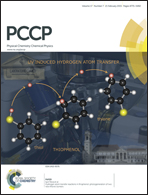Chemistry specificity of DNA–polycation complex salt response: a simulation study of DNA, polylysine and polyethyleneimine†
Abstract
In this work, the chemistry specific stability determining factors of DNA–polycation complexes are examined by performing all-atom molecular dynamics simulations. To this end, we conduct a systematic variation of polycation line charge through polyethyleneimine (PEI) protonation and polycation chemistry via comparison with poly-L-lysine (PLL). Our simulations show that increasing line charge of the polycation alone does not lead to more salt tolerant complexes. Instead, the effective charge compensation by the polycation correlates with the increased stability of the complex against additional salt. The salt stability of PEI–DNA complexes also links to the proton sponge property of weak polycations, commonly assumed to be behind the effectivity of PEI as a gene delivery vector. Examination of the complexes reveals the mechanism behind this behaviour; more Cl− ions are attracted by the protonated complexes but, in contrast to the common depiction of the proton sponge behaviour, the ion influx does not cause swelling of the complex structure itself. However, PEI protonation leads to release of PEI while DNA remains tightly bound to the complex. Jointly, these findings shed light on the stability determining factors of DNA–polycation complexes, raise charge distribution as an important stability determining contributor, and indicate that the effectivity of PEI in gene delivery is likely to result from the freed PEI facilitating gene transfection.


 Please wait while we load your content...
Please wait while we load your content...